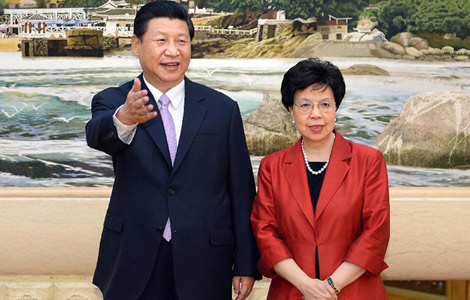China tops US in phone use
Updated: 2013-08-21 11:03
By Michael Barris in New York (China Daily)
|
||||||||
|
A man checks on his smartphone at a bus stand displaying a tablet computer advertisement in Beijing on Monday. Andy Wong / AP |
More Chinese than Americans use a smartphone as their primary media device, but more Americans depend on it so much that they would "never leave home without it", according to a study.
The study surveyed more than 4,500 smartphone users - including 3,500 in China and 1,000 in the US. Conducted by two trade associations - the New York-based Interactive Advertising Bureau (IAB) and the Interactive Internet Advertising Committee of China (IIACC) - it compared consumer-usage habits in the world's two major smartphone markets. It found that smartphone ownership changes users' media-consumption habits to a greater degree in China than in the US.
More than a quarter of the Chinese smartphone owners surveyed reported 28 percent less TV watching and 27 percent less consumption of print media as a result of owning a mobile-connected device, according to the study. Compared with their US counterparts, Chinese smartphone owners were 86 percent more likely to report less TV viewing and 42 percent more likely to report less consumption of print media, the study showed.
The data showed Americans depend far more (69 percent to 6 percent) on the smartphone as a device they would "never leave home without", according to the study.
Approximately one-third of the surveyed Americans said their smartphone is the "first thing I reach for when I wake up," as opposed to 7 percent for the Chinese.
US smartphone owners also were "much more likely" than those in China to multitask with the phone, according to the study. For instance, while watching TV, more Americans than Chinese simultaneously used the phone to communicate via the Internet, (51 percent to 10 percent), to read social media (38 percent to 9 percent) and to conduct a local search on the World Wide Web (34 percent to 8 percent).
The study, which was designed to help marketers, agency professionals, and publishers tailor strategies to reach consumers in both countries, showed similar results when it came to reading print media - suggesting the phone itself may not have been the key cause of the disparity.
The study also found that Chinese use the phones strictly as a web browser more than Americans (32 percent to 21 percent). More than one-fifth of Chinese respondents said they spent three hours or more per day using their phones to troll the Internet for "entertainment".
The study comes amid China's emergence as the world's largest smartphone market, helped by buyers' embrace of low-cost, basic smartphones. In the first quarter, smartphone shipments in China skyrocketed 117 percent from the same period a year earlier to 78 million units, according to New York-based market research provider International Data Corp.
IDC predicted that smartphone shipments will increase sharply this year, reaching 460 million units - for a market value of $117.8 billion - by 2017.
The smartphone boom in emerging nations also has been helped by wireless companies' willingness to subsidize buyers' phone purchases in hopes of locking them into long-term deals. Typically, customers pay a discounted price up front for their phones and then work the cost off over the course of a long-term contract.
The average price of a smartphone has plunged to $375 from $450 since the beginning of 2012, IDC estimates.
The price drop is reminiscent of the fall in personal-computer prices in the late 1990s when prices tumbled to $1,026 in 2002 from $1,898 in 1996, according to IDC.
"The market is becoming less about speeds and feeds, and more about price," Kevin Restivo, an analyst at IDC in Toronto, told Bloomberg News. "More people don't need to be overwhelmed by a phone, so long as it's good enough."
Although China already is the world's largest smartphone market, IDC's Restivo predicts that 66 percent of the 384 million smartphones sold in China next year will cost less than $200, compared with 14 percent of the 153 million phones projected to be sold in the U.S.
Emerging markets also have seen a smartphone surge because of the popularity of prepaid phone plans - where customers pay as they go and top up their account as their remaining level of service drops. Payments cover messages, voice, multimedia and data. In the US, where a long tradition of postpaid plans prevails, users pay for their usage at the end of the month. Contracts designate a set amount of voice minutes, text messages, and data.
Linda Sui, an analyst for Strategy Analytics, attributed China's faster smartphone growth to more advantageous phone packages in China that allow users to pay as they go, particularly for the ability to use the Internet - whether that means watching YouTube videos, listening to Internet radio or e-mailing photos.
Smartphone popularity in the US to an extent is affected by the data charges in plans, Sui said. "That is "a key difference" between the US and China, she said.
michaelbarris@chinadailyusa.com
(China Daily USA 08/21/2013 page2)

 Merkel makes historic visit to Nazis' Dachau camp
Merkel makes historic visit to Nazis' Dachau camp
 Chinese fleet sets sail for joint drills
Chinese fleet sets sail for joint drills
 President Xi meets WHO director-general
President Xi meets WHO director-general
 Everyman movie star
Everyman movie star
 Rural boarding schools need dorm managers
Rural boarding schools need dorm managers
 Center of hope and support
Center of hope and support
 Chinese characters under threat in digital age
Chinese characters under threat in digital age
 US, China to expand military exchanges
US, China to expand military exchanges
Most Viewed
Editor's Picks

|

|

|

|

|

|
Today's Top News
China urges US flexibility on N. Korea
China tops US in phone use
NBA hosts Chinese coaches
China asked to help in African mining
Dispute slows positive trend on Korean Peninsula
Food safety tops public's concerns
Chinese fleet sets sail for joint drills
Children with HIV live in fear
US Weekly

|

|








